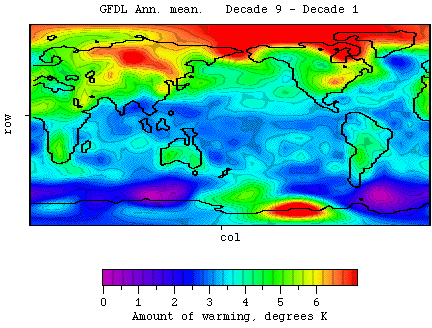Greenhouse warming, the Arctic, and Antarctica
|
E. Linacre and B. Geerts |
3/’02 |
|
Global Climate Models (GCMs) generally agree that warming due to increased greenhouse gas concentrations is predicted to be most intense in high latitudes. For instance, the GFDL GCM predicts a 100-year temperature change of about 3K globally and 5K near the poles (Fig 1). This is largely because melting sea ice changes the albedo of high latitude oceans, and to a lesser extent because an inversion prevails at high latitudes, especially in winter, whereas at low latitudes the heating is convectively mixed througout the troposphere. There is some strange patch of warming around Antarctica (Fig 1). This is probably due to a change in deep-ocean circulation. It seems likely that global warming will have different effects near the North and South Poles. The Arctic (north of 60° N) is warmed by about 6.5K in the GFDL GCM, whereas the equivalent Antarctic region warms by only 3.5K. This is because more warmth in Antarctica would allow the air to hold more water vapour, leading to increased precipitation and so a thickening of the snow cover. So no albedo-induced warming over the Antarctic continent is expected. On the other hand, the Arctic continental ice sheets (mainly Greenland) are expected to melt, and the area and thickness of the ice in the Arctic Sea will shrink, driving a strong albedo feedback. The good news of this analysis is that sea level should rise little. |
Fig 1. Change of surface temperature between 1990 and 2090, as predicted by the Geophysical Fluid Dynamics Laboratory (GFDL) GCM forced by the anticipated change in atmospheric gas composition. (Source: National Climate Data Center) |
